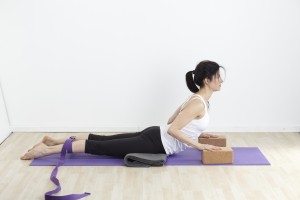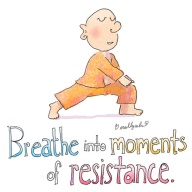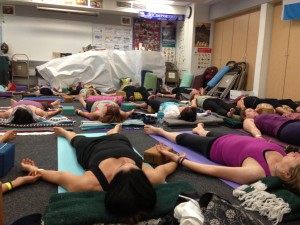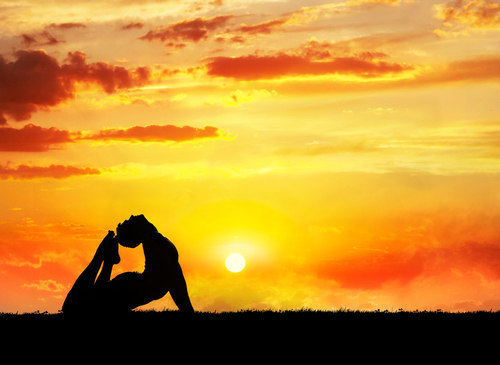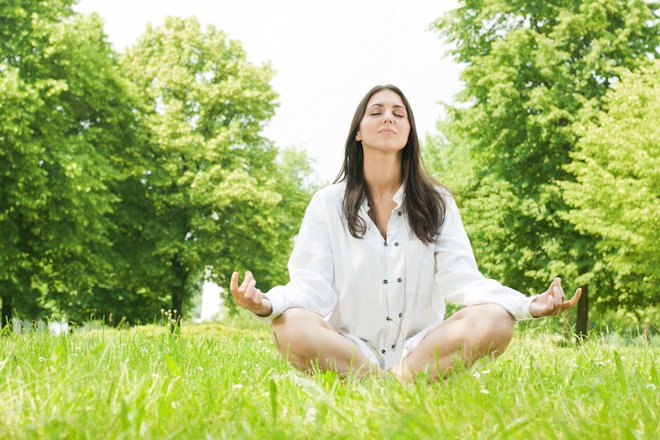 I am thankful for the support offered to me and for the ability to recognize it !
I am thankful for the support offered to me and for the ability to recognize it !
Category Archives: Blog
Cobra Pose
Yoga Therapy moment
BHUJANGASANA (cobra pose)
Yoga Therapy For The Solar Plexus
Using time on the mat to open to who you actually are gives great feedback to your mind, body, spirit. This shift in perception will transform your practice into a truly therapeutic one which is ultimately healing for you.
I taught this asana to someone today who came in after a week of feeling “tied up in knots”. She acknowledged that there was a particularly large accumulation of stored tension in what felt like a knot at “the solar plexus. This person’s week was wrought with job related anger, frustration, plus the daily routine of home and family. She is also someone who does little backbending, as many of us, being seated all day and since she is also rather new to Yoga I reached out to one of the classic poses, cobra – Bhujangasana.
Simple, yet complex, this mild to strong backbend has many benefits including:
- Strengthens the spinal column
- Stretches chest and lungs
- Stretches the abdomen and stimulates the organs in the abdominal cavity
- Stabilizes the shoulders, and abdomen
- Firms the buttocks
- Helps relieve stress especially emotional/digestion issues and fatigue
- ‘Opens’ the heart by energizing the area
- Soothes sciatica (if done with this in mind, such as with the strap around lower limbs)
- Therapeutic for asthma
- Traditional texts say that this posture increases body heat, destroys disease, and awakens kundalini.
Shown here, this posture could certainly stabilize the SI and shoulder joints. The belt is looped around the lower legs so that the heels and sitting bones are in alignment. The blocks under the hands are used to ‘seat’ the shoulder blades on the back, thus providing much freedom for the neck, and release for tight upper trapezius. The blanket helps cushion the hips and gives just the right amount of lift to maintain the frontal spinal alignment and a backbend that is distributed equally through all segments.
Sometimes trying a pose that you do regularly with a few well-placed props gives you such great feedback that you may do it differently from there on out; even the most well intentioned of us can overdo with ego driven “I can do it” mentality. Not worth it. You have a lifetime to practice in, so use time on the mat to open to who you actually are. This honesty and acceptance is transformational. This shift in perception will transform a posture done with an exercise orientation into a trully therapeutic and healing one. You can do my Chakra Balancing Meditation at the end of your session to refresh your entire system. Note that you need to warm up and do counterposes to stay safe.
How to move into the pose:
- If you are using a strap, it is easiest to stand on your knees, reach back and slide the belt up to the shins, then stretch out on tummy.
- Press the tops of the feet and thighs and the pubis firmly into the floor, a blanket under the hips helps establish symmetry.
- If you are using the blocks, they should be positioned such that the shoulders seat on the back. On an inhalation, begin to press the hands into the blocks so that the shoulders are stable, then visualize a zipper running from the front of the spine all the way up the and another one running from the crown of the head down the spine. Only lift the chest off the floor to the height at which you can maintain a lengthening. Avoid the tendency to push the front ribs forward, but do allow the sternum to stretch up. Firm but don’t harden the buttocks.
- Distribute the backbend evenly throughout the entire spine.
- Hold the pose anywhere from 15 to 90 seconds, breathing easily. Release back to the floor with an exhalation.
Next Exit: A Healthy Life
I have always chosen to stay healthy. Yoga has played a huge role for me in this process. More than an exercise routine for the body, Yoga is alternative medicine, and in my mind, its value as a system of preventative health care is beyond belief.
Often, our busy lives lead to feelings of stress and burnout. Perhaps one of the best ways Yoga, used therapeutically, can benefit this state is in teaching us to relax during challenges. Side benefits also include improving our energy, our breathing capacity, our immune system, our ability to focus, sleep, think clearly. Better posture means better joint stability and function, flexibility, strength, and cardiovascular conditioning. Not only that, but a meditative mind is able to be happier and feel empowered, connected, and enriched. It is, above all else, a practical methodology for living life well.
This being said, there are other things we need to do to maintain our health. I advocate regular visits to your health and dental professionals. I have lived most of my life in Canada, where there is Medicare, and many things are covered. However, I also had private health care coverage which was one of the benefits of working for a family owned company at one point.
Now I am looking into establishing residency in the United States, and am trying to familiarize myself with health care in a new system. I know that when I am ready, I am going to have to investigate private health care, and navigate the best plan for myself. It looks like a lot to research, so I am breaking it down, and sharing a few simple tips.
- Research in your area to see which companies offer what.
- Ask yourself what your priorities are.
- Find out what the range of products and coverage is.
- Check out the websites and use their contact form to ask questions; you can then get a glimpse into how they process clients.
For example, if we choose a company for fun such as Aviva , we can see what area this company covers, what their products are and how this fits in with our vision of what we are looking for. We can also use their contact form, ask questions, get a quote. From there, maybe there is another company to compare it with, we can make a spread sheet to compare, take ten breaths to focus and we are good to go.
A YOGA MIND plus good health care coverage seems smart and prepared; you want healthy practices and support for these practices in order to feel like you are doing your best
Peaceful Warrior
My latest post on MindBodyGreen
For many of us, the end of summer can mean an end of a relaxed pace of life. Whether we are going back to work or back to school or simply returning to busier routines, there can be an underlying sense of worry due to these new pressures.
Unfortunately, worry is often accompanied by anxiety, fear, and stress. These emotions trigger out flight-or-flight response, so that we sleep less, take shallow breaths, digest poorly, and react from an overall cranky place.
Ease or disease; we’re equipped to handle both. The one we give more attention to will get stronger, like a muscle…
I am not going to tell you that there is a magic wand to make worry go away, but you can adopt strategies to bring your mind under control, which is what the entire system of yoga is about. This should not be underestimated since the mind is responsible for conjuring the worry up in the first place.
Here are 7 ways you can cultivate yoga mind and become a peaceful warrior instead of a nervous worrier:
1. Try putting first things first rather than attacking everything at once.
2. Practice patience and LETTING GO and LETTING GOD with one thing.
3. Try to balance out the go go go with a bit of go with the flow. A restorative yoga pose is a great beginning.
4. Visualize your worries as hecklers at the comedy show, and try to use their lines to improve your material 🙂
5. Practice yoga not to escape, but to help illuminate the way.
6. Meet yourself where you are on your mat by adding a yoga prop so there is a sense of honoring yourself.
7. We neutralize stress as it comes up…this does not mean sweeping things under the rug, perhaps by learning to use the breath as a tool for managing the emotions.
Why not take a moment now to bring your palms together in front of the heart, into Atmanjali Mudra (gesture of prayer)? Affirm that you are grateful for this moment and connect with your heartbeat and the rhythm of your relaxed breathing.
Feel it as a moment of peace, harmony, balance, repose, and the heart’s desire. As a result, you may feel more clear and rested so you may want to do it more often…
Let me know how it goes.
South Bay Yoga Conference – Review
My after buzz from the South Bay Yoga Conference is still going strong
As an east coast Yapana yogini I was pretty honored to be invited as a presenter along with my California friends from Leeann Carey Yoga.
I was welcomed, not only by a wonderful team of fellow teachers, but also impressed by an extremely well run event, thanks to Jules Mitchell and her great staff. Josepf and I kicked off the weekend with Partner Yoga taught by Ansley Herndon which was the best choice for us! There was an array of free offerings: great music, free and purchasable eats (seriously yummy stuff) as well as a great marketplace where you could shop til you dropped. I did, but luckily there were body workers with affordable options for quick massage. The weather was lovely, the students were open, inquisitive, interested and interesting. Plenty to see and do in this scenic area too. I cannot wait to go back next year, not sure just yet what my workshops will be about, so keep in touch and hope to see you there in 2014. If you missed it, check out this calming video clip:
To Prop or Not To Prop?
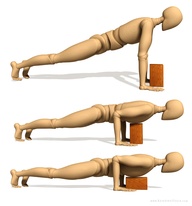 My latest post on MindBodyGreen: 7 Reasons to Modify Your Yoga Practice With Props
My latest post on MindBodyGreen: 7 Reasons to Modify Your Yoga Practice With Props
Some of the yoga classes I attended 20 years ago were very minimalist in terms of yoga props. The yoga mat industry was much younger as well, and the choices of mats was limited to thin and thicker. At the studio where I taught we did have straps and cylindrical bolsters, but they felt hard to use, and didn’t really improve my practice or lend too much therapeutic tone to the class. In fact, some teachers felt that using props was both forceful and made it seem like the yoga equivalent of cheating at Scrabble.
Fast forward to an era where there are different kinds of mats, from eco friendly to exra absorbant. Yoga walls are popping up and the prop business has really taken off at the speed of OM. So why is it that some people scrunch up their faces and turn a cold upper trapezius when they hear the phrase “modify the practice to suit your needs?”
This is actually the key to understanding yoga therapy, as we teach that yoga isn’t a “one-size-fits-all” practice even though it’s accessible to everyone. I believe finding your modifications instead of tying yourself up in knots trying on poses the way everyone else is doing them is both positive and empowering.
Using a strategically placed prop can open your body, increasing range of motion, flexibility, and strength. Sometimes one muscle group becomes dominant because it overworks, which leaves other areas weak and underdeveloped. Using support doesn’t mean collapsing into it. On the contrary, using the prop as feedback provides valuable information, especially about what your unique yoga needs are.
Here are seven reasons to turn your physical practice of YOGA into YOGAtherapy. A well-placed prop can:
1. Help you learn the skill involved in sustaining alignment.
Have fun with it!
on contentment
Latest blogpost on MindBodyGreen

Every time I think of the word “happiness,” I recall one of my favorite poems by Ven. Lama Gendun Rinpoche: “Happiness cannot be found through great effort or willpower, but is already present in open relaxation and letting go,” he writes.
Wow! Powerful, right? It is certainly easier to connect to a feeling of happiness when you’re not being tested, but is this your default setting? If pressure builds up, do you breathe and release, reboot and move forward with peaceful gratitude, or do you store it, build steam and explode? When things aren’t so easy, what are your attitudes, perceptions, and coping strategies? Is it still contentment, or is this reserved for the one day all the bills are paid, you’ve slept and have eaten well? In other words, are you content regardless of your situation?
Contentment, Patanjali says in Sutra 11.42 is dynamic, as opposed to complacency, which is stagnant. We should be able to look at our life, weed out the toxic relationships and situations to then rebalance on all levels. This requires changing what isn’t working. It also asks us to want what we have, be grateful and see a crisis as a crossroads.Contentment brings us to a new perception of how things are, which calms the mind. It is an attitude that’s independent of outside influences. What you have or don’t have does not change the essence of who you are.
Here’s what you need to do to turn your frown upside down, view adversity as opportunity and connect with the contented you:
1. Stop comparing yourself and your life to others; we all have gifts.
2. Give away something you don’t need; there’s always someone who could use it.
3. When you find yourself complaining, listen to yourself and write down two options for bringing change.
4. Repeat the mantra, “Thank you” more often; it cleans up taking things for granted.
5. Sit, breathe, relax and reboot.
6. Practice (safely) an energizing backbend, to open the body and allow new energy to flow to you.
7. Write down one thing today that makes you smile, and let that energy permeate your core.
Tough times provide opportunity for great inner strength and to connect deeply with what’s important to us. Allow this sustaining virtue of grateful contentment to take root in your life so that your default setting is now rewired for peace and positivity.
Photo Credit: Shutterstock.com
7 Reminders To Keep Your Yoga Practice Pure
7 Reminders To Keep Your Yoga Practice Pure
Featured on MindBodyGreen By Rana Waxman
Around this time of year, you seem to begin to hear more about “spring detoxes,” “spring cleaning,” and, “cleansing.” Even non-yogis are hailing kale and dropping the “cleanse” buzzword. So what does it all mean? Where does the special focus come from and why this time of year?
Cleanliness, or purity, is an ongoing part of the yoga system. Patanjali calls our attention to it in sutra 11.40: “Purity protects one’s body and brings nonphysical relationships with others.” According to T.K.V. Desicachar, the word tapas in the yogic system means, “Something we do in order to keep us physically and mentally healthy; a process of inner cleansing. We remove things we do not need.”
For those of us who had a cold winter, spring is when Mother Nature’s sunny smile makes things defrost and blossom; the maple syrup runs, we shed boots, scarves, hats and sweaters. We reorganize our closets to find our lighter clothing. We often have runny noses, allergies are irritated with all the pollen in the air, and the body tries to decongest itself of excess mucous.
Some students and friends have been telling me they’re exhausted, their joints hurt, and they’re feeling completely lazy. You don’t have to call it “cleansing” or feel like a hot toxic mess, but you may want to change up a few things to keep that spring in your step and the purity in your yoga practice. Here are seven things to be mindful of as we transition from one season to the next.
1. Food
Add more greens and fresh food to your menu (pizza is not your boyfriend, so just date it once a week).
2. Movement
Twists and forward bends tone the liver; walking outside to get some fresh air, listening to the birds and watching the new budding flora tone the spirit.
3. Rest
Go to sleep a little earlier in order to wake up rejuvenated.
4. Breathe
Make friends with a Neti-pot.
5. Write
Journal to get all these lurking negative emotions OUT.
6. Clean
Spruce up your closet and give what you don’t need to charity.
7. Shhh
The meditative state of silence and deep relaxation cleanses the mind!
Giving yourself a little extra support during any transition is a positive act. Just keep in mind that beyond all the recipes for detoxing is the system of yoga itself, which supports maintaining nourishing habits and self-reflection throughout the year. No matter how green you eat, if you’re not in touch with yourself emotionally, you won’t be able to rest and digest.
Photo Credit: Shutterstock.com
Happy Passover
Use Mantras to Focus Your Mind and Change Your Life
Use Mantras to Focus Your Mind and Change Your Life
published on MindBodyGreen
Photo Credit: Shutterstock.com


